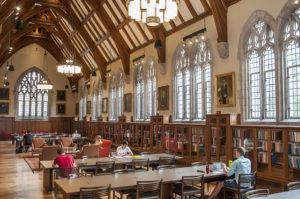Study spaces on campus are public spaces shared by the student population. In the MOOC, Penalosa discusses recent changes he implemented as mayor in his city to change the atmosphere of its public spaces. He points out that we need to walk and see or be with people in order to be happy.
Many of the designated study spaces that we have on campus, namely the libraries, have sections that have cubicles. While this can be an effective way to ensure focus, it does not seem like a healthy study pattern long term. In line with Penalosas observations, I have experienced feeling motivated when I see others studying around me and I feel better if I don’t feel confined and trapped in a cubicle. While some people choose to literally walk while studying, like at the gym on the treadmill reading notes, etc, the concept of moving can be applied to a study space. By studying in an open, naturally lit, plant filled environment with a component of motion(ex. swivel chairs vs. static chairs), I have found that I can focus more intently for longer. Just as the mayor had to allocate public space for bus space, sidewalk space, bike space, etc. the same planning must go into the design of a study space. The best example of this on Duke’s campus may come from Perkins Library- there is Vondy that provides coffeeshop vibes, large tables by windows, group study tables, half cubicles by windows, private rooms, lounge chairs, full cubicles in the middle of stacks, a mix of static and mobile chairs. It makes sense that a main library would be able to cater to all different types of people with different study habits, needs, and tendencies. Penalosas would say that the library distributes the space in a democratic way.



